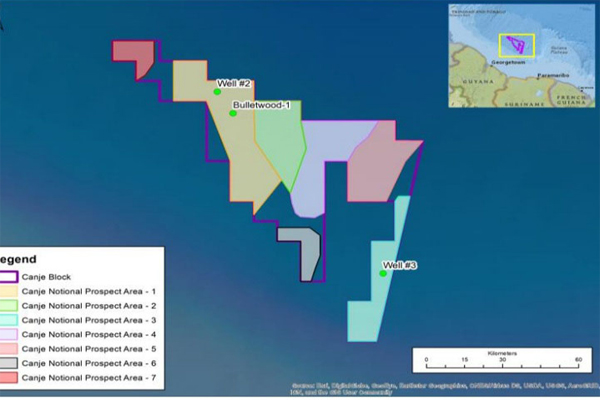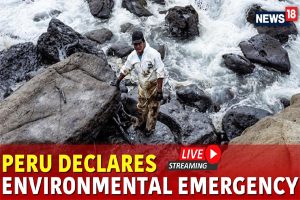
Kaiteur News
GEORGETOWN
EnergiesNews.com 03 08 2022
Hundreds of tons of waste will be generated on a monthly basis as oil giant, Exxon through its subsidiary Esso Exploration and Production Guyana Limited (EEPGL), embarks on its 12-well drilling campaign in the Canje Block, but the Environmental Protection Agency (EPA) has exempted the operator from conducting an Environmental Impact Assessment (EIA) for the three-year drilling programme, despite being warned that it could yield adverse effects.
The EPA, in a recently published notice to the public on its website explained that the application by Exxon has been screened by the agency to assess the potential environmental impacts. To this end, the EPA has concluded that the project will not “significantly affect the environment or human health.” However, the operator will be required to prepare and submit an Environmental Management Plan (EMP) for the project.
In its project summary for the 12-well campaign, Exxon pointed out that while similar impacts from its other campaigns could be expected from this project, these could be adverse.
According to the Canje Project Summary, “The potential impacts, which are expected to be similar to impacts identified in previous exploration/appraisal drilling Environmental Assessment and Management Plans in the Canje, Kaieteur, and Stabroek Blocks, could be directly and/or indirectly generated by the Project during drilling and/or abandonment, and such impacts could be adverse or positive in nature.”
When it comes to the positive impacts of the project, Exxon said capacity will be built in the local labour force. “The Project is expected to build capacity in the local labour force, increase demand for skilled labour, and increase demand for service industries,” the oil company noted.
On the other hand, the document said that air quality, marine geology and sediments as well as marine water quality may be impacted. It adds that sea turtles, sea birds, marine mammals and even fish can suffer as a result of the project due to noise disturbance, offshore lighting, wastewater effluent discharges, non-routine or unplanned events such as an oil spill or vessel strike and non-routine temporary flaring, among others.
It was keen too that this campaign could potentially “stress” the capacity to manage wastes in Guyana.
EEPGL is hoping to commence its drilling campaign in the fourth quarter of this year and wrap up in the first quarter of 2025.
Kaieteur News understands that based on the water depths in the Canje Block, multiple dynamically-positioned drill ships would be used to drill the wells.
The Canje 12-well programme aims to gather data on the reservoir characteristics, hydrocarbon presence, pressure, and temperatures. If the presence of hydrocarbons is discovered, wells will be tested to establish the limits of the reservoir. Additionally, the productivity of wells and the oil or gas properties present will be tested. Once the proposed drilling operations are complete, the exploration well will be permanently plugged and abandoned.
Back in September last year, this publication reported that with regard to hazardous waste, oily residue between 31 and 77.6 tons each month will be generated.
As it relates to non-hazardous waste, the company says it envisions this at between 46 and 100 tons each month, while sanitary and domestic waste see amounts of up to 4,500 tons each month.
Industry stakeholders have until March 18, 2022 to send queries and concerns to the EPA regarding the 12-well campaign for the Canje Block.
The Canje Block is located offshore, in deepwater of Guyana, southeast of the Kaieteur Block, and north-northeast of the Stabroek Block, where EEPGL has conducted substantial exploration and development activities to date. Based on data from these exploration and development activities, EEPGL said the proposed 12 exploration/appraisal wells may be drilled within seven Prospect Areas.
While some of the 12 wells will be drilled for exploration purposes, EEPGL said it is also possible that some of the wells may be drilled as appraisal wells within proximity of previously drilled exploration areas. If discoveries are found, at particular locations, the company said subsequent wells could be drilled in the vicinity of such locations to further assess the commerciality of the discoveries. Priorities and schedules could therefore change, it said.
Award of Canje Block
For several years, this newspaper was at the forefront of calls for there to be a thorough, independent investigation into the award of two blocks – Kaieteur and Canje – since several industry stakeholders who examined the matter, concluded that they were awarded under suspicious circumstances.
The Canje Block was awarded by the Donald Ramotar administration on March 4, 2015, days before the elections that year. The former President said he acted on the advice of the Guyana Geology and Mines Commission (GGMC) and then Minister of Agriculture, Robert Persaud.
When Persaud was asked who the oil block was granted to, he said he never met them and could not remember. When further pressed, he said he could not even remember the lawyers who signed on behalf of the owners.
kaiteurnewsonline 03 08 2022












